Watercress is the superfood vegetable on everyone’s mind these days, and that’s because it was dubbed the “healthiest vegetable in the world” by the Centers for Disease Control (CDC). Granted, it was back in June 2014 when watercress topped the list of a report called “Defining Powerhouse Fruits and Vegetables: A Nutrient Density Approach,” but the news has resurfaced over the last few weeks, spurred by what looks to be one very successful marketing campaign by B&W Quality Growers. The produce manufacturer used the 2014 CDC scoring as a way to get more people to start buying watercress, and everyone from Vogue to the New York Post subsequently covered the leafy green’s benefits. Now, we can perhaps thank this strange game of reporting telephone for drudging up old news and reminding us just how nutrient-dense and beneficial watercress can be.
Now, back to the report that started it all: Researchers at William Paterson University in New Jersey sought to take common “powerhouse” fruits and vegetables like different leafy greens, citruses, and cruciferous vegetables, and give each of these foods a ranking based on their “nutrient density.” Among the biggest heavy hitters were cabbage, chard, and spinach, but the only food to earn a perfect score of 100 was watercress. According to the CDC, this means that “the food provides, on average, 100% DV of the qualifying nutrients per 100 calories.”
To learn even more about watercress beyond its nutrient density, we talked with a handful of dietitians to find out what exactly this powerhouse vegetable can do for your body and for your health. Read on, and for more healthy eating advice, make sure to check out 7 Vegetables That Reduce Inflammation and Slow Aging.
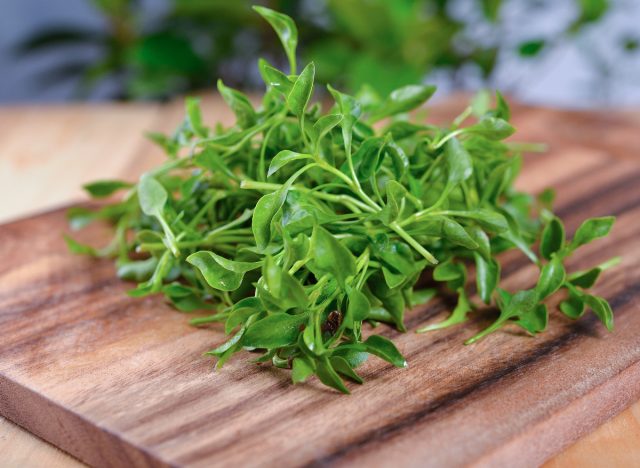

When you chop up some watercress for your salad, smoothies, or sandwiches, you’ll be giving your body some powerful compounds with anti-inflammatory properties. “Watercress has anti-inflammatory effects, which can help the body combat oxidative stress,” says Lauren Manaker, MS, RDN, a registered dietitian on our Medical Expert Board.
But where exactly does watercress get these anti-inflammatory qualities? “One of the most noteworthy features of watercress is that it is the best source of a compound called Phenethyl isothiocyanate (PEITC),” says Manaker. “This compound has been linked to effects like a reduction of growth of certain cancer cells and has anti-inflammatory and antioxidant effects.”
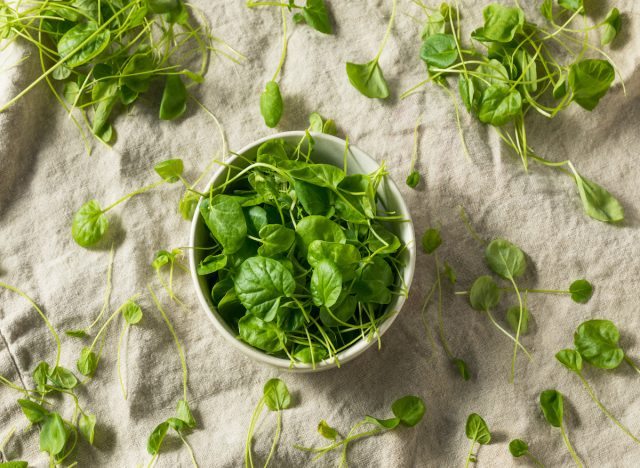

You often hear of eating foods like kale or broccoli to get more vitamin K into your diet, but watercress is another vegetable with a high K vitamin count. In fact, a cup of watercress has about 85 micrograms of vitamin K, and the daily recommended amount for adults is around 120 micrograms, so you’re getting close by consuming just one serving. But what does vitamin K do?
“This aqueous veggie has an impressive amount of vitamin K, which is a nutrient that helps the body clot blood,” says Manaker. “Vitamin K also is an important nutrient that can support bone health.” Harvard Health says that some research has also found that vitamin K may help with heart health.
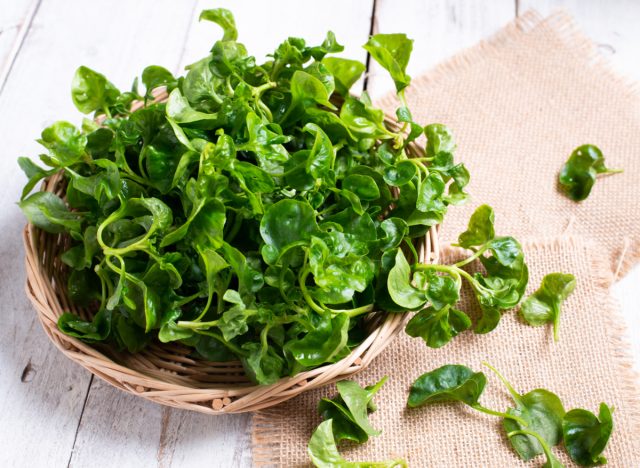

Watercress is made up of vitamins and minerals that have been proven to be beneficial to the health of your heart. “For one, it is free from saturated fat and has an insignificant amount of sodium, and these two factors are important when choosing foods that support heart health,” says Manaker. On top of that, “Watercress also contains the three key micronutrients emphasized on the DASH diet—calcium, magnesium, and potassium.” The DASH diet is specifically focused on lowering blood pressure and cholesterol, and watercress can be a nutritious part of this eating plan.
In addition, watercress also contains dietary nitrates, “which can promote healthy blood vessels, improve blood flow, and help regulate blood pressure,” says Amy Goodson, MS, RD, CSSD, LD. “These nitrates are converted into nitric oxide in the body, a compound that relaxes blood vessels and supports cardiovascular function.”
READ RELATED: 4 Alarming Indicators Of High Cholesterol In Your Eyes
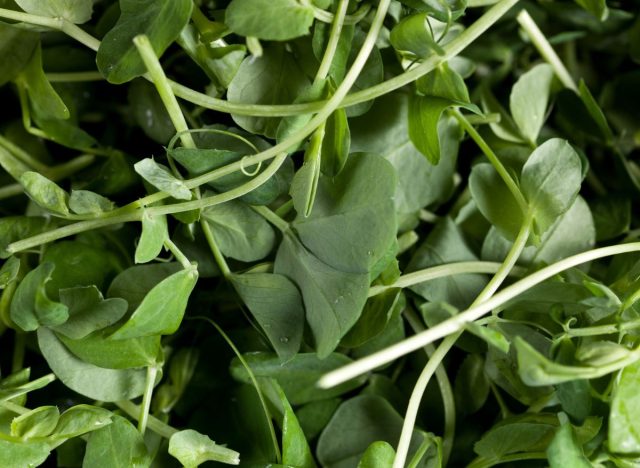

According to Manaker, watercress contains compounds that may help protect against the development of macular degeneration, which is an age-related issue that can affect the retina. This vegetable can be helpful for your eyes in this case because “Watercress is a natural source of lutein and zeaxanthin—two compounds that support eye health,” says Manaker.
A report published in Nutrients states that plant compounds like these can help protect against age-related issues because of their ability to reduce oxidative stress damage, but lutein and zeaxanthin are specifically found in the retina, which is why they are linked to helping with macular degeneration.
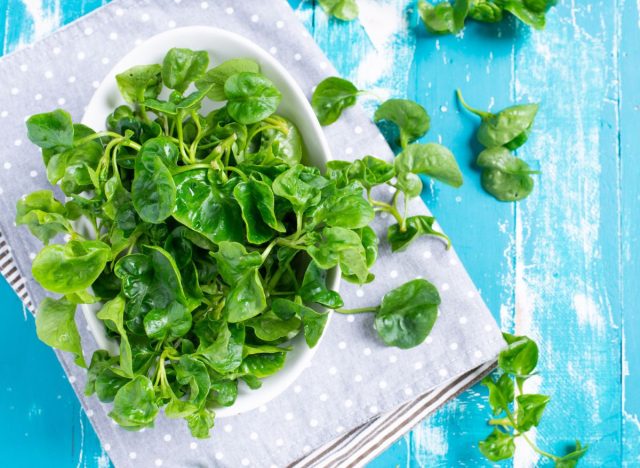

In order to protect your bones as you age, it’s important to take in a variety of helpful nutrients through all types of foods. According to our dietitians, watercress can help by providing essential minerals for your bones.
“Watercress is rich in essential minerals that promote optimal bone health, encompassing calcium, magnesium, potassium, and phosphorus,” says Trista Best, MPH, RD, LD at Balance One Supplements. “While calcium is widely recognized for its influence on bone health, magnesium, vitamin K, and potassium also hold significant roles.” Best further explains that vitamin K is helpful in the health of your bones because it constitutes a vital element of osteocalcin, a protein integral to robust bone structure and the regulation of bone turnover.”


One major benefit of chowing down on some watercress, whether it’s on top of a salad or mixed into a smoothie, is that you’re gifting your body with a multitude of nutrients, vitamins, and minerals, all while consuming very few calories at all—less than 4 per cup!
“Overall watercress is low in calories while being nutrient-dense, thus becoming an excellent choice in your diet without adding excess calories,” says Lisa Young, PhD, RDN.
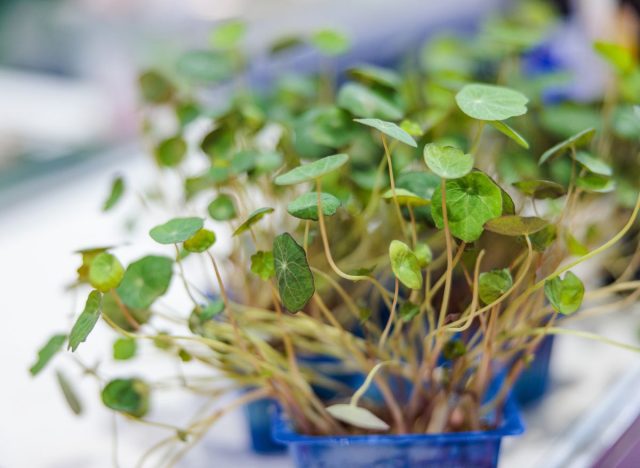

As you can see by now, watercress is quite the powerhouse of a vegetable. Along with its potential to help your heart, bones, eyes, and reduction of inflammation, this green also contains compounds linked to cancer protection.
“Research suggests that watercress may have anticancer properties,” says Goodson. “It contains bioactive compounds like glucosinolates, which can have a protective effect against certain types of cancer by inhibiting the growth of cancer cells and promoting their elimination.” She adds that “the presence of antioxidants and other phytochemicals in watercress further contributes to its potential in reducing cancer risk.”









